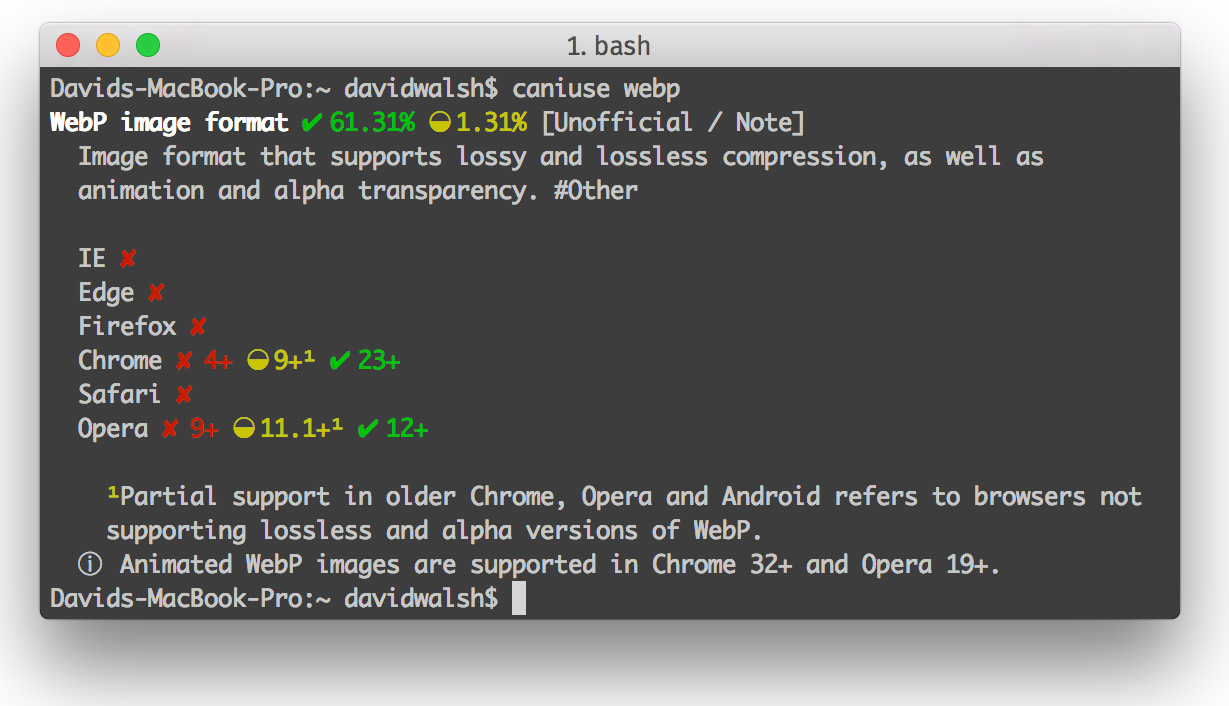CanIUse Command Line
Every front-end developer should be well acquainted with CanIUse, the website that lets you view browser support for browser features. When people criticize my blog posts for not detailing browser support for features within the post, I tell them to check CanIUse: always up to date, unlike posts on any blog. While I know to use the CanIUse website, I recently found out that Sam Gentle has an accompanying Node.js CanIUse module for looking up browser support.
To install the utility, use a typical npm install command:
# Install globally for less hassle
npm install -g caniuse-cmd
With the caniuse command available, you can look up feature support from the command line:


The display of results is pretty and it provides a listing of different matching features if the lookup is vague. And because we can get this information in an automated way, you can probably write a decent scraper with cURL and other tools.
![5 Awesome New Mozilla Technologies You’ve Never Heard Of]()
My trip to Mozilla Summit 2013 was incredible. I've spent so much time focusing on my project that I had lost sight of all of the great work Mozillians were putting out. MozSummit provided the perfect reminder of how brilliant my colleagues are and how much...
![From Webcam to Animated GIF: the Secret Behind chat.meatspac.es!]()
My team mate Edna Piranha is not only an awesome hacker; she's also a fantastic philosopher! Communication and online interactions is a subject that has kept her mind busy for a long time, and it has also resulted in a bunch of interesting experimental projects...
![Google-Style Element Fading Using MooTools or jQuery]()
Google recently introduced an interesting effect to their homepage: the top left and top right navigation items don't display until you move your mouse or leave the search term box. Why? I can only speculate that they want their homepage as...
![Form Element AJAX Spinner Attachment Using MooTools]()
Many times you'll see a form dynamically change available values based on the value of a form field. For example, a "State" field will change based on which Country a user selects. What annoys me about these forms is that they'll often do an...







I need to get this hooked up to be an email responder bot! “Hey Steve does
${browserX}support${featureY}?” => auto respond ;-)How about just adding canIuse as a search engine to your browser, like so http://caniuse.com/#search=%s?
Simply typing “c webp” into my browser gives me even nicer formatted results.
Sadly the output is not very useful for automated processing. It would’ve been nice if this could be implemented in a gulp-task, scanning CSS for a defined set of supported browsers, and if a css-declaration wasn’t supported it would throw an error.
But as your example of ‘transform’ shows, it returns things like JPEG2000, so output parsing is required and tedious. Plus it seems that there is no option to print a simple boolean instead of fancy ticks and crosses.
There’s also this package available via npm.
https://www.npmjs.com/package/caniuse-api
Perhaps this would work better for that task.
Definitely an interesting article about this new npm tool, useful for those who like command line better then gui.